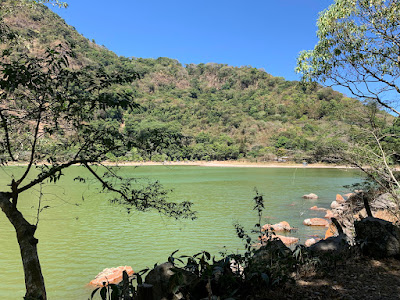It's Wandering Week! Let's walk around a lagoon
El Salvador is a land of volcanoes - a land of volcanoes and of craters and of lagoons. Some lagoons are mostly known by photographs, like the elusive green lagoon which rests inside crater of the Santa Ana Volcano (The lagoon is often hidden in the clouds, disappointing hikers who make the long trek to the summit.) Some lagoons, like the large crater lakes Ilopango and Coatepeque are very accessible for tourists and locals who want to enjoy some fun on the water or along the shore. Some lagoons are remembered for what they left behind as they evaporated or drained away, like at the base of El Boquerón or El Jardín Botánico La Laguna (literally named "The Lagoon Botanical Garden." And, some lagoons, like the one featured in this story, are just the right size and shape to circumnavigate and explore in a walk of an hour or two.
One recent, sunny Saturday morning, we drove east from San Salvador to Usulután for a day of fun with some friends. Our activities were centered around the town of Alegría. Following a cobblestone road up from the town, we found our way to a beautiful emerald lagoon - La Laguna de Alegría. The small, sulfuric lake is located in the crater near the summit of the Tecapa Volcano. The volcano is dormant, but the earth below the surface is alive with plenty of geothermal activity. In fact, there is a geothermal power plant located not too far from Alegría in the town of Berlin. Minerals and gases in the water are what produce the greenish color of the lagoon.
 |
| Entrance to the Laguna de Alegría park - it's a one-way road around the lagoon, and probably involves driving through water during the rainy season. |
 |
| Aquatic plants appear red and purple. The dried plants along the shore are a strange texture - it's like walking on crispy purple crackers that turn into gray powder when you crunch them |
We visited this lagoon during the dry season, and with the lower water level, it was possible to walk all the way around the circumference of the lake without getting our feet wet. What a fun place to explore! In some places, the pure, gray clay was slippery - just perfect for giving our hands an impromptu spa treatment. Near the clay deposits, vents caused the water to bubble and boil. In other places, vents allowed sulfur gas to escape from the earth, with its characteristic rotten-egg smell. The gas from the vents was warm and moist.
 |
| The water is colored by clay in this shallow area |
 |
| Watch where you walk! Vents are hidden in the rocks and mud. |
The interior of the crater is partially forested. Picnic areas dot the shady sections of the pathway around the lake, and families gathered to relax and eat their lunches. A few vendors were set up near the parking area, selling cotton candy and sour mandarin oranges. As we walked, we noticed an architectural feature which likely is a waterfall during the rainy season. There were tennis courts and some other structures which gave the impression that this may have been the site of a spa or resort at one time.
At the other end of the lagoon, there is a small public school. We really wondered: where do the children live? We couldn't really see any homes close to the lagoon or in the crater. It also seemed like during the rainy season, the school would be at risk for flooding.








Comments
Post a Comment